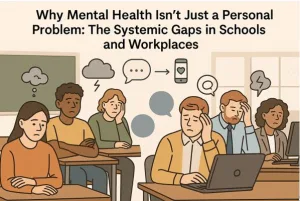Why Mental Health Isn’t Just a Personal Problem: The Systemic Gaps in Schools and Workplaces

Mental health is often framed as an individual responsibility, something you manage privately, outside of work or school. But the truth is, mental health is deeply shaped by the systems we’re part of. Schools and workplaces play a huge role in how people feel, cope, and function every day.
When these environments lack proper support, the consequences are far-reaching: higher stress levels, disengagement, long-term burnout, and even long-term health challenges. Let’s explore why schools, employers, and companies often fail to provide the right mental health support and how these gaps impact both students and employees.
The Hidden Gaps in Student Mental Health Support
In many schools, mental health is sidelined by academic priorities. According to the American School Counselor Association’s analysis of NCES data, high-school counselors handle caseloads of 178 – 326 students, while their elementary/middle-school counterparts are responsible for 581 – 702 students, each number that leaves little room for individual support. Meanwhile, already-overextended teachers rarely receive the training or time to spot early signs of distress.
The result is a silent crisis: the CDC’s 2023 Youth Risk Behavior Survey found that 40 % of high-school students felt persistently sad or hopeless, 20 % seriously considered suicide, and 9 % attempted suicide. When left unaddressed, these emotional challenges erode academic performance, strain peer relationships, and undermine long-term self-esteem.
How it impacts students:
- Increased absenteeism and poor academic outcomes
- Feelings of isolation or disengagement from school life
- Long-term risks of anxiety, depression, and burnout before adulthood
Text therapy and online mental health counseling platforms have started to fill this gap, offering discreet, on-demand support that meets students where they are. But until schools prioritize mental health at the same level as academic success, the crisis will continue. The most effective solution involves institutionalizing student mental health services as a core component of school infrastructure.
The Overlooked Needs of Employees in Workplaces
For working adults, mental health challenges are often exacerbated by high-pressure work cultures. Deadlines, performance expectations, and limited boundaries between work and personal life can quickly lead to stress. Yet many companies fail to recognize that employee well-being directly affects productivity, retention, and morale.
Even when wellness programs exist, they’re often underutilized because they’re inaccessible, poorly communicated, or seen as superficial perks rather than essential support. Many employees don’t feel safe discussing their struggles at work, fearing stigma or career repercussions.
How it impacts employees:
- Decreased engagement and lower productivity
- Increased absenteeism and presenteeism (working while unwell)
- Higher turnover and long-term burnout across teams
This is why organizations are now exploring corporate wellness software and wellness apps for employees that provide flexible, confidential mental health support. From text therapy options to mindfulness programs, these tools make it easier for employees to seek help without fear of judgment.
Why the Lack of Structured Support Hurts Everyone
When schools and workplaces fail to address mental health proactively, it doesn’t just harm individuals, it disrupts entire communities and organizations. Students who don’t receive help early may carry unresolved issues into adulthood, impacting their careers and relationships. Employees who feel unsupported may lose motivation, disengage, or leave altogether, costing organizations valuable talent.
The ripple effect is clear:
- Unaddressed stress leads to long-term health costs
- Environments become less inclusive and more isolating
- Productivity, creativity, and overall morale decline
By treating mental health as a shared responsibility rather than an individual burden, schools and workplaces can create healthier, more resilient communities.
The Cost of Ignoring Mental Health

It’s easy for schools and employers to view mental health as a secondary concern, but the costs of neglect are undeniable. For schools, untreated mental health challenges often lead to higher dropout rates, classroom disruptions, and a decline in overall school performance. When students don’t feel emotionally safe, their ability to learn, build confidence, and form positive relationships is severely compromised.
In workplaces, the financial toll is just as significant. Studies show that organizations lose billions annually due to lost productivity from stress-related absenteeism and presenteeism. Employees who feel unsupported are also more likely to disengage from their work, creating a ripple effect that affects team morale and company culture. Over time, this leads to higher turnover rates, increased recruitment costs, and a loss of institutional knowledge.
What’s more, ignoring mental health needs can damage the reputation of schools and companies. Today’s students and employees expect environments that prioritize well-being. Those that fail to adapt risk being seen as outdated or uncaring, which further affects enrollment, retention, and overall trust.
This is why proactive mental health strategies, whether through corporate wellness software, wellness apps for employees, or scalable student mental health services, are no longer optional. They’re a critical investment in the future success of both individuals and institutions.
The Way Forward
Scalable digital platforms, like text-based counseling, AI-powered mental health tools, and employee-focused wellness software, can bridge the gap where traditional systems fall short.
Supporting mental well-being isn’t just the “right thing to do”, it’s essential for thriving classrooms and workplaces. When we invest in accessible, structured support, we reduce stress, prevent burnout, and help people show up as their best selves every day.
